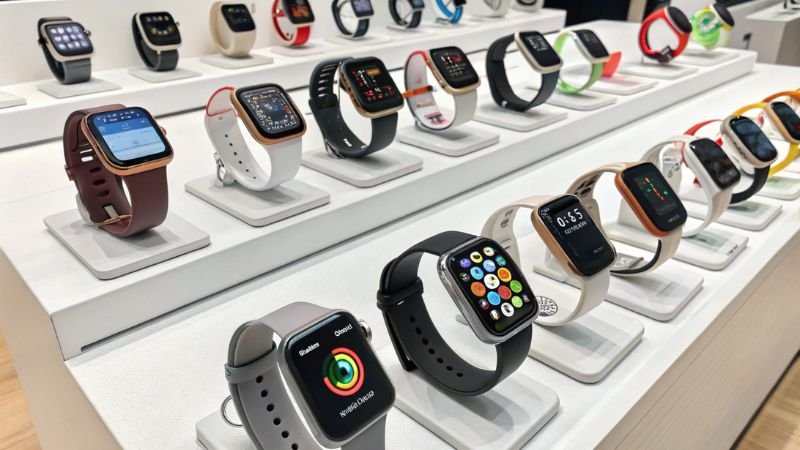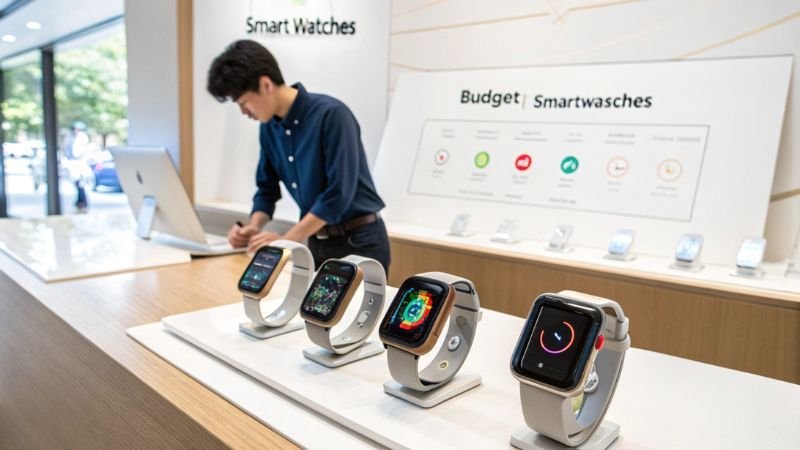A Seller’s Guide to 7 Types of Smartwatches: What to Sell, Why, and Who to Target?

The smartwatch market is thriving, offering sellers an incredible chance to tap into a growing demand. But with so many models and features available, how do you decide what to sell, why it matters, and who your audience is? Let me break it all down for you.
Smartwatches fall into distinct categories, each designed to meet specific user needs, ranging from fitness tracking to health monitoring, and even kids’ safety. Aligning your product offerings with the right audience will maximize sales and customer satisfaction.
The key to success in this industry lies in understanding the market trends, identifying your target audience, and selecting the right product mix. Let’s dig deeper.
What Are the Categories of Smart Watches?
Smartwatches are versatile, and their categories reflect the diverse needs of users. Understanding these classifications can help you tailor your inventory to meet customer demands effectively.
The seven main smartwatch categories include fitness trackers, health monitors, outdoor/sports watches, kids’ smartwatches, fashion-focused smartwatches, hybrid models, and flagship smartwatches. Each has unique features and serves a specific market segment.

Breaking Down the Categories
-
Fitness Trackers: These are compact, lightweight, and designed for activity tracking. Features typically include step counting, calorie tracking, and heart rate monitoring. They appeal to fitness enthusiasts and casual exercisers.
Examples: Fitbit Inspire series, Xiaomi Mi Band. -
Health Monitors: Advanced watches equipped with features like ECG, blood oxygen monitoring, and fall detection. Ideal for older adults or those managing chronic health conditions.
Examples: Apple Watch Series, Garmin Venu. -
Outdoor/Sports Watches: Rugged and durable, these watches are built for extreme conditions and outdoor activities. Key features include GPS, altimeters, and water resistance. They cater to hikers, runners, and athletes.
Examples: Garmin Fenix, Suunto 9. -
Kids’ Smartwatches: Designed for parental peace of mind, these watches include GPS tracking, call features, and geofencing. Parents often buy them for safety purposes.
Examples: Verizon GizmoWatch, TickTalk 4. -
Fashion-Focused Watches: Sleek, stylish designs aimed at fashion-conscious buyers. They often allow customization and are great for pairing with formal or casual outfits.
Examples: Fossil Gen 6, Michael Kors Access. -
Hybrid Watches: A blend of traditional analog watches with smart functionalities like step counting or basic notifications. They target professionals or minimalists who value aesthetics but don’t need advanced features.
Examples: Withings Steel HR, Garmin Vivomove. -
Flagship Smartwatches: High-end devices packed with features like LTE, advanced health monitoring, and app ecosystems. These are perfect for tech-savvy customers looking for premium products.
Examples: Apple Watch Ultra, Samsung Galaxy Watch.
| Category | Key Features | Target Audience |
|---|---|---|
| Fitness Trackers | Steps, calories, heart rate | Gym-goers, casual exercisers |
| Health Monitors | ECG, SpO2, fall detection | Older adults, health-focused buyers |
| Outdoor/Sports Watches | GPS, rugged build, water resistance | Athletes, adventurers |
| Kids’ Watches | GPS, geofencing, calls | Parents, kids |
| Fashion Models | Stylish, customizable | Fashion-conscious buyers |
| Hybrid Watches | Analog looks + smart features | Professionals, minimalists |
| Flagship Watches | LTE, advanced features | Tech enthusiasts, pros |
Which Smart Watch Sells the Most?
Sales trends in the smartwatch market reveal clear winners among the categories, primarily driven by affordability, features, and brand reputation.
Fitness trackers and health monitors are the top sellers, driven by their practicality, affordability, and broad appeal. They resonate with both everyday users and enthusiasts.

Why Fitness Trackers and Health Monitors Dominate
- Affordable Price Points: Fitness trackers are budget-friendly, making them accessible to a wide audience.
- Health Awareness Trends: Post-pandemic, consumers prioritize health monitoring, driving demand for SpO2, ECG, and heart rate tracking.
- Brand Recognition: Established players like Fitbit and Garmin have built trust, simplifying purchasing decisions for consumers.
For sellers, focusing on these categories ensures a steady flow of demand. Market these as lifestyle essentials, highlighting how they improve daily routines and overall well-being.
Are Cheap Smart Watches Any Good?
Low-cost smartwatches often get a bad reputation, but many budget models offer excellent value for money. They are ideal for expanding your customer base to include price-sensitive buyers.
Budget smartwatches provide essential features like step counting, notifications, and basic health tracking, making them a good choice for entry-level users. With careful sourcing, quality can be ensured.

Pros and Cons of Selling Budget Models
-
Advantages:
- Affordable for first-time buyers.
- Mass-market appeal in price-sensitive regions like Southeast Asia or South America.
- Easy entry point for younger audiences or students.
-
Challenges:
- Quality consistency can vary between brands.
- Limited features compared to mid-range or premium models.
Examples of reliable budget brands include Xiaomi, Amazfit, and Realme. As a seller, prioritize quality control and test these products thoroughly before stocking them.
Which Is the Biggest Smartwatch Brand?
Brand power drives consumer trust, and understanding the top players can help you leverage their popularity to boost your sales.
Apple leads the market, followed by Samsung and Garmin, thanks to their innovation, quality, and brand recognition. These companies set the tone for the entire industry.

Insights on Market Leaders
- Apple: Dominates with its Apple Watch series, seamlessly integrating with the iOS ecosystem. It appeals to high-end buyers and loyal Apple users.
- Samsung: Offers diverse options for Android users, combining premium features with sleek designs.
- Garmin: Specializes in outdoor and fitness watches, catering to athletes and outdoor enthusiasts.
As a seller, consider stocking brands that offer compatibility across multiple platforms (iOS and Android) to attract a broader audience.
What to Do Before Selling Smart Watches?
Preparation is key to success in any business, and selling smartwatches is no exception. Setting a strong foundation can make or break your venture.
Thoroughly research the market, vet suppliers, and test products to ensure quality and compliance with regulations. These steps will position your business for success.

Your Roadmap to Starting a Smartwatch Business
- Market Research: Identify top-selling features and trending categories, such as health monitoring or outdoor tracking.
- Supplier Verification: Partner with manufacturers who provide certifications like CE, FCC, and RoHS to meet export standards.
- Product Testing: Order samples to assess quality, durability, and performance.
- Regulatory Compliance: Familiarize yourself with import/export regulations and certifications required in your target markets.
- Marketing Strategy: Develop a plan to highlight your products’ unique selling points, whether it’s customization options or fast delivery.
| Task | Action |
|---|---|
| Research | Analyze trends and buyer needs. |
| Supplier Selection | Confirm certification and reliability. |
| Product Testing | Verify quality through thorough checks. |
| Marketing Prep | Plan campaigns to highlight features. |
Conclusion
Selling smartwatches is a lucrative opportunity if approached strategically. By understanding the categories, focusing on high-demand products, and preparing thoroughly, you can succeed in this competitive market.


